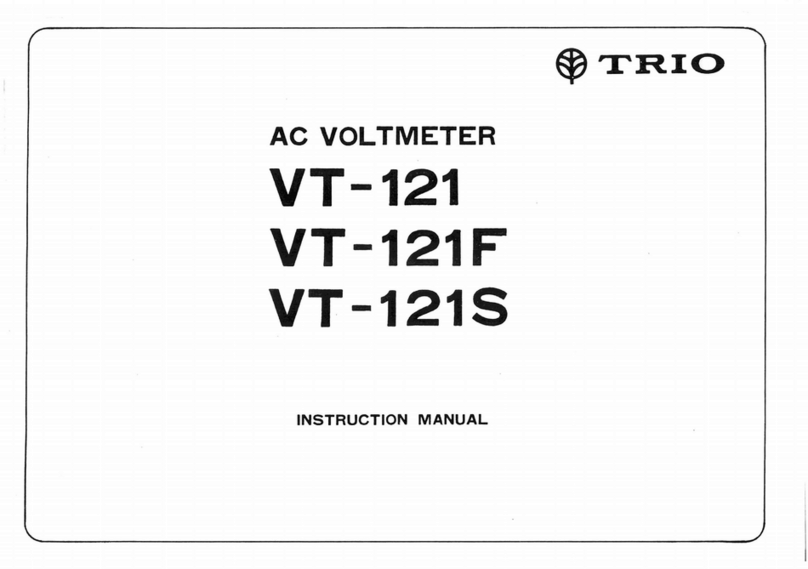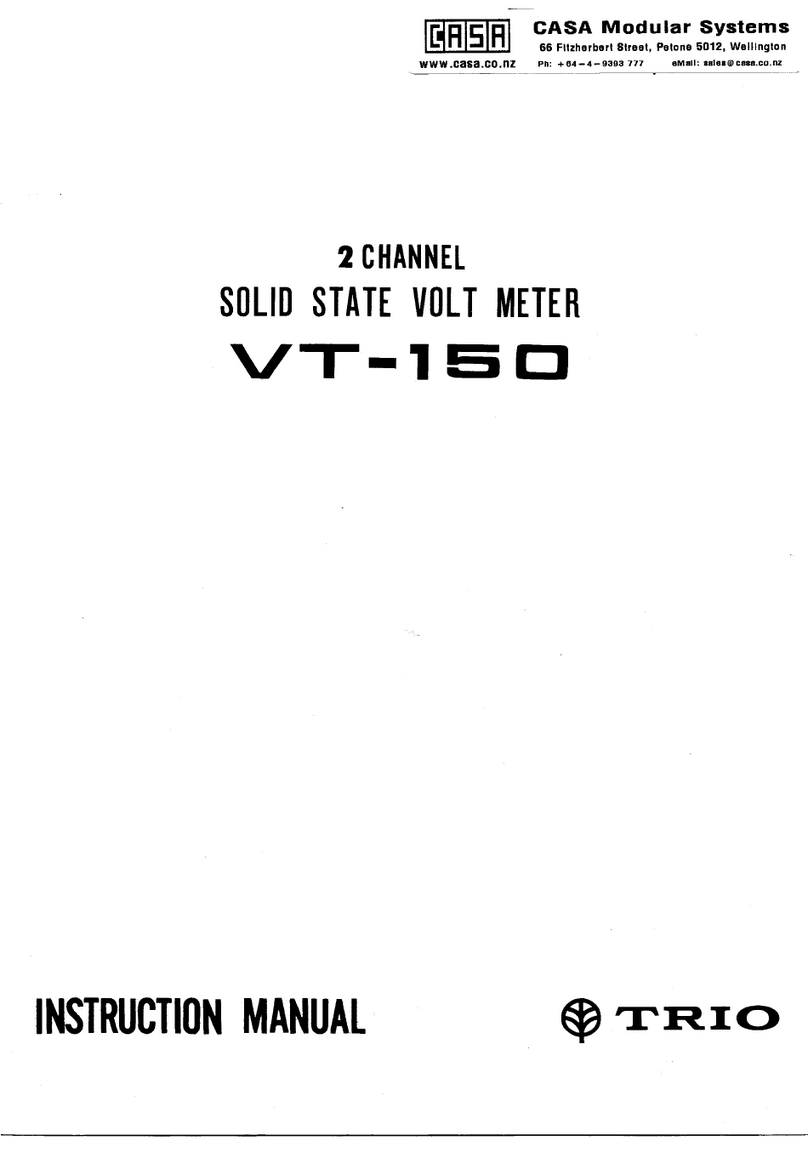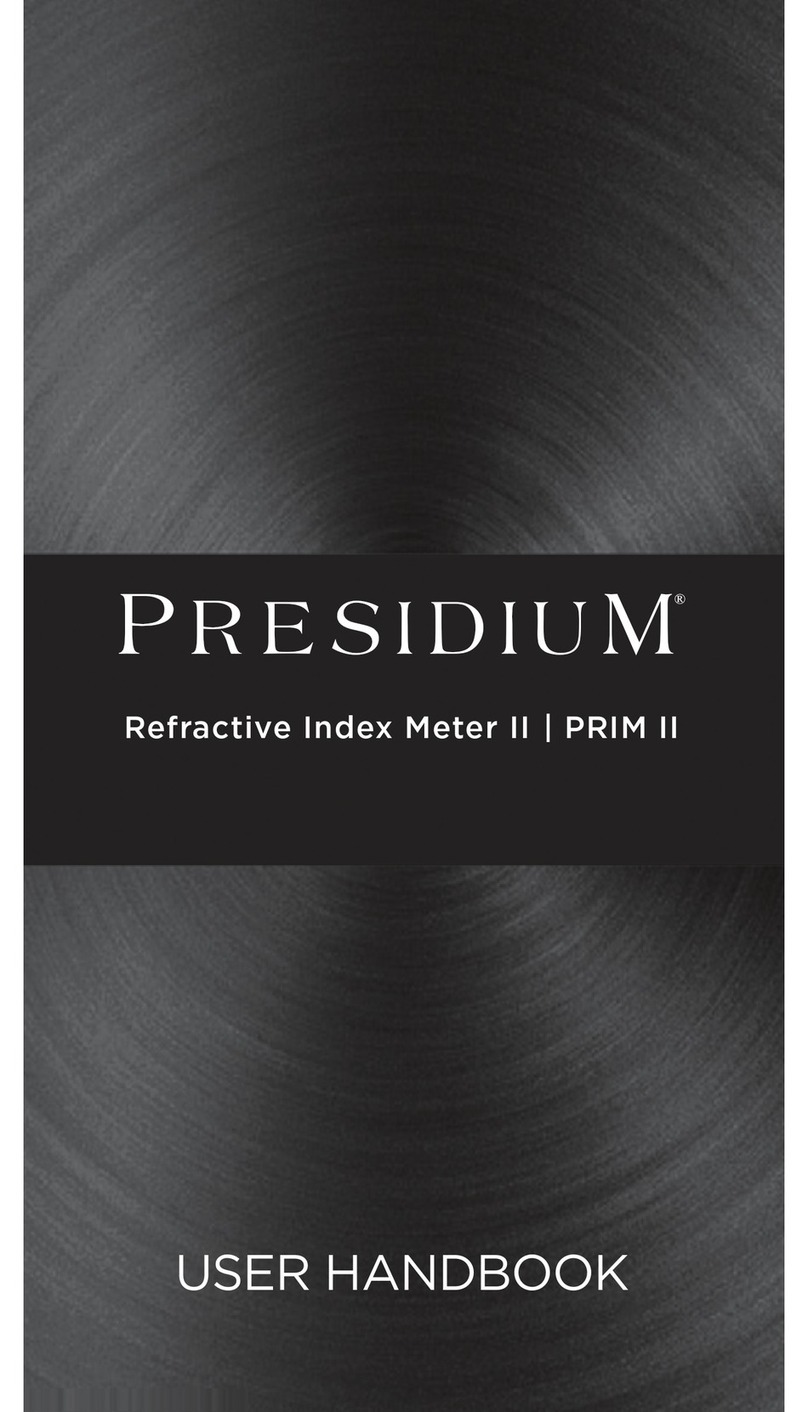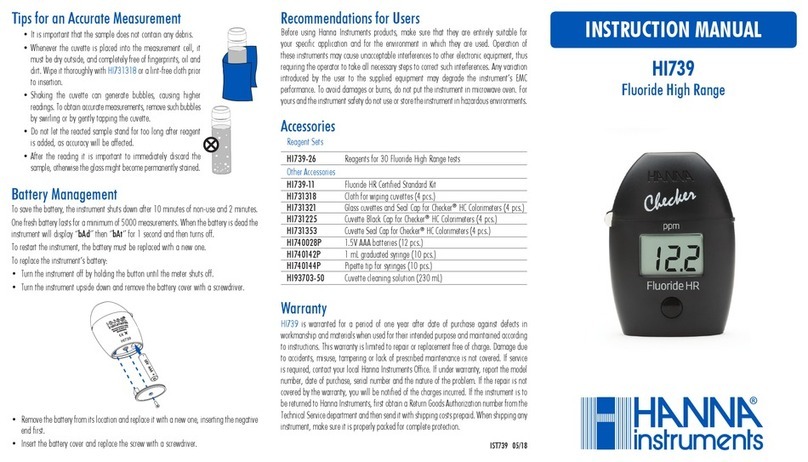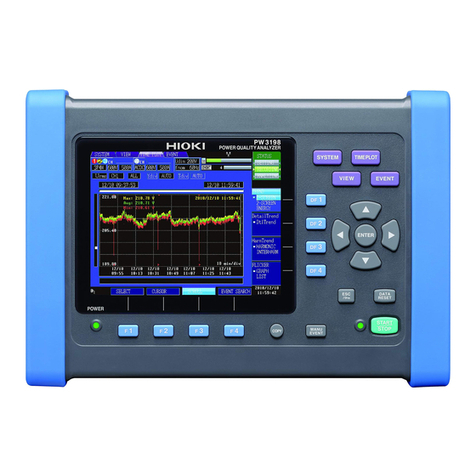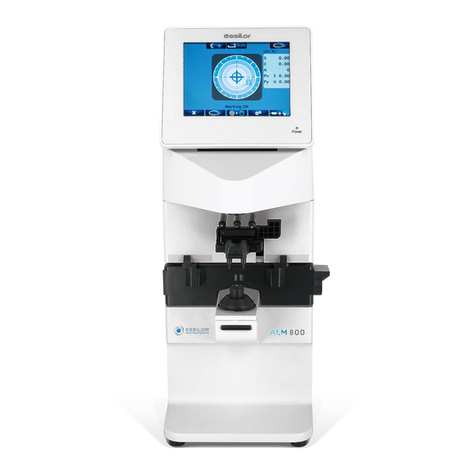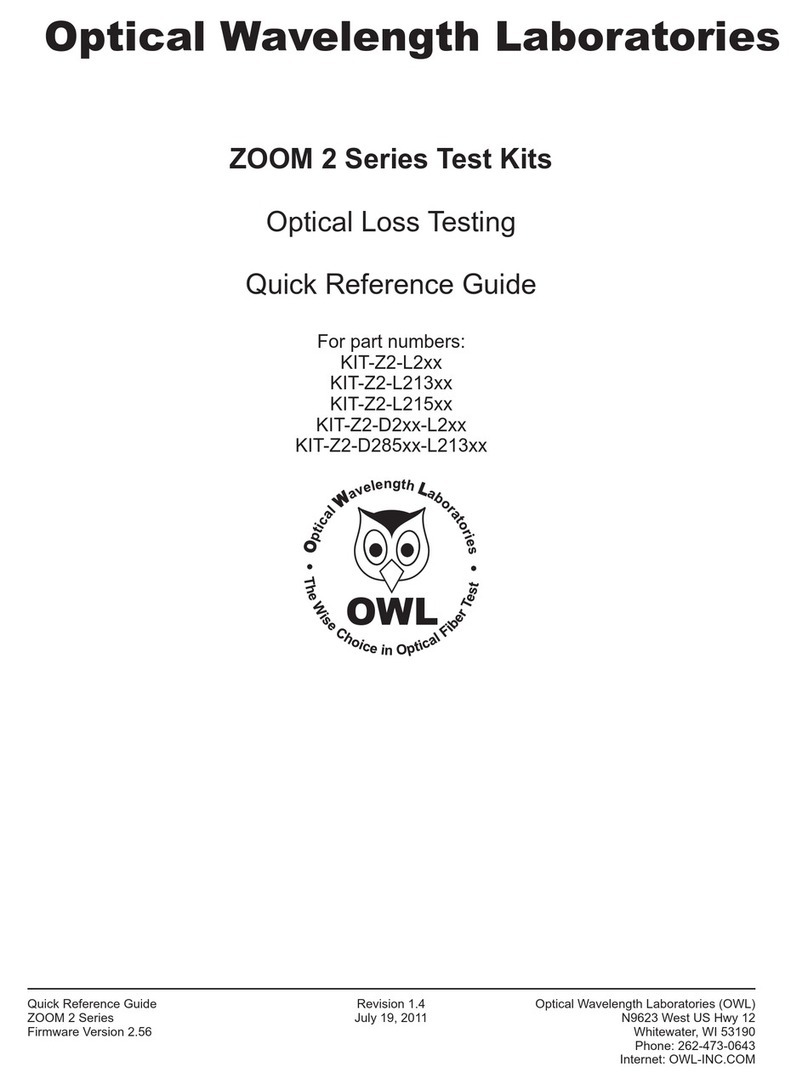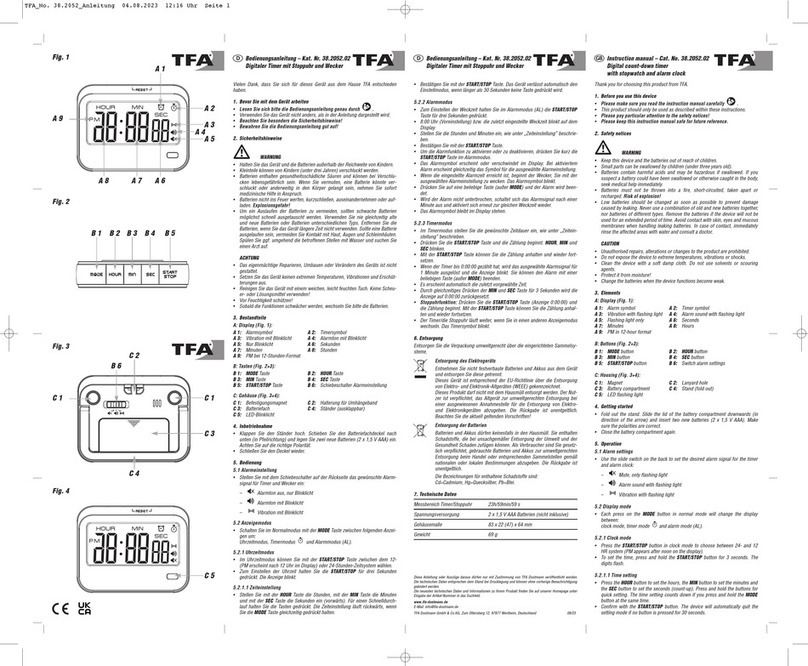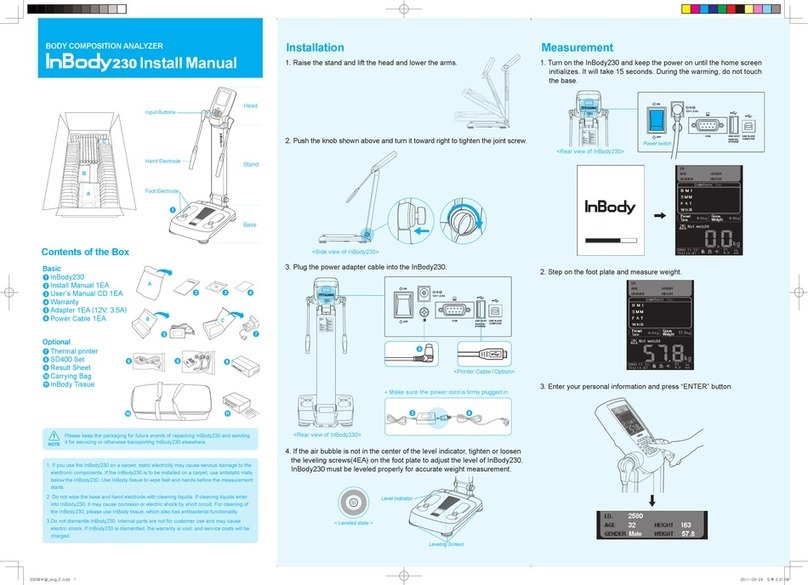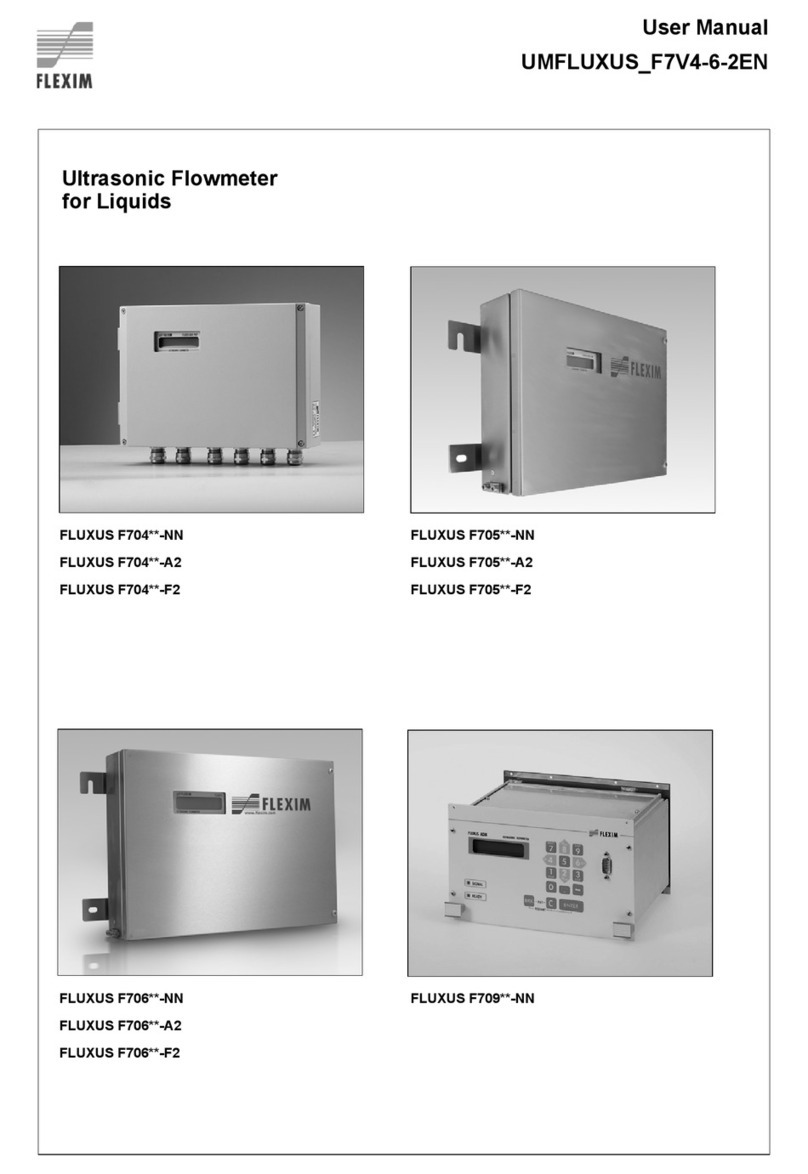Trio VT-126 User manual

WWW.C3S3.CQ.rll
Pfl·
-+-fi4-4-!t:.!l;f
Ill
t~Mml:
saln~:(ulf!asa.co.lll
VT-126
(VT-125)
HIGH SENSITIVITY VOLTMETER
(NOISE METER)
INSTRUCTION
MANUAL
~TRIO

2
GENERAL
The Noisemeter is an ultra-sensitive electronic
voltmeter
having a
maximum
sensitivity
of
1O#V fullscale
(:lO
pV,
tor
the
VT
-125)
Its
wide
frequency range covers
from
10
Hz
to
500
kHz (1
mV
~
300V)
and the five types
of
weighting
are
selectable. In addition, DIN or
CCI
R quasi-peak or average
detection
with
RMS
display
is
selectable. making possible
S/N
and noise measurements in accordance
with
JIS-A.
DIN NOISE, DIN AUDIO.
CCIR
and
CCIR/ARM
standards
The
units
are also provided
with
an overload indicator and a
10
dB range relative reference adjustment. AC and DC
out-
puts are provided and remote control
of
range
switching
is
available
to
facilitate
use on
the
production line.
CONTENTS
GENERAL
..
..
..
..
..
.. ..
..
..
..
..
..
..
..
..
..
..
..
..
..
.
..
.. .. ..
. 2
FEATURES
.................................................
2
SPECIFICATIONS......................................
3
CIRUIT
DESCRIPTION
..............................
9
CONTROLS
AND
INDICATORS
................
10
OPERATION
..............................................
13
PRECA
UTI
0 N
............................................
14
MAINTENANCE
......................................... 15
ADJUSTMENT
...........................................
15
APPENDIX
.................................................
17
PARTS LIST
...............................................
21
P.C.
BOARD
AND
CIRCUIT
DIAGRAM
................................
30
*
VT-126:
10
J.N
fullscale
maximum
sensitivity
with
0.2
J.N
graduated scale for measurements
down
to
-120
dB
VT-125:
Maximum
sensitivity
of
30
J.-tV
fullscale.
*Button
selection
of
JIS-A
DIN NOISE. DIN
AUDIO.
CCIR
and
CCI
R/
ARM
weighting
filters make possible noise
measurements and
S/N
measurements in accordance
with
a variety
of
standards.
* In addition
to
average
detection
and
RMS
display, DIN
and
CCI
R semi-peak
detection
with
R
MS
display is
available for measurements
in
accordance
with
those
standards.
*
AC
OUT and DC OUT
terminals
are
provided
to
facilitate
waveform
observation, recording
of
measured values or
use
of
the
unit
as
an amplifier.
* A relative reference
adjustment
from
0
~
- 10 dB
makes possible relative measurements
of
signals
with
respect
to
an arbitrarily set reference level. particularly
useful in
S/N
measurement.
*
An
overload indication prevents
measurement
errors
caused
by
distortion
not
detected
by
the
operator by
viewing
the
meter
level for use
with
the
weighting
filters.
* Logic control is used
for
range selection
making
this
func-
tion
remote
controllable (option).

ITEM
VOLTMETER
t----
Voltage
ranges:
Display
accuracy:
Frequency response:
SPECIFICATIONS
VT-126
101N
-~
300V
I10,.tV/301JV/1001'V/3001'V/1
mV/3
mV/10
mV/
30
mV/
100
mV/300
mV/1
V/3V/10V/30V/100V/
300V
fullscale)
dB -
100
-~
t
50
dB
IO
dB
=c
1
V)
dBm
-98
~
+52
dBm
IO
dBm
= 1
mW/600)
With
average detection, in FLAT
mode
10
11
V and
30
11V
range
within
:+:
5%
of
fullscale
1
0011V
-~
300V
range
within
±3%
of
fullscale
With
quasi-peak detection and DIN NOISE.
DIN
AUDIO
or
CCI
R
weighting
filter
10
11V
range:
withm
17%
of
fullscale
30
11
v
-~
300V
range
within
±5%
offullscale
With
average
detection
and RMS drsplay
10
11
V range:
20Hz
-~
10kHz
10Hz~
30kHz
30
11
V
-~
300
11V
ran~w
20Hz
~
20kHz
10Hz-~
100kHz
1 mV
~
300V
range
20Hz
~
100kHz
15
Hz
~
300
kHz
1
0
Hz
~
500kHz
With
quasi-peak detection and RMS display
1011Vrange
30Hz-~
15kHz
20Hz
~
20kHz
10Hz-~
30kHz
+5%
±10%
t 5%
_1_10%
±3%
_t5%
±10%
+5%
+10%
+20%
j
VT-125
301'V
~
300V
130 11V/100
IJV/300
11V/1
mV/3
mV/10
mV/
30
mV/100 mV/300
mV/1V/3V/10V/30V/100V;
300V
fullscale)
dB
-90~t50dBIOdB=1V)
dBm
-88
~
+52
dBm
IO
dBm
= 1
mW/600)
t-------~--------------------------~-----
With
average
detection
in FLAT
mode
30
11V
range:
within
t 5%
of
fullscale
10011V
-~
300V
range wrthrn
+3%
of
fullscale
With
quasi-peak detection and DIN NOISE,
DIN
AUDIO
or CCIR
weighting
filter
301'V ~
300V
range
within
t
5%
of
fullscale
'-
----------------~
With
average detection and RMS display
30
11V
~
300
11
V range
20Hz
~
20
kHz
10Hz~
100kHz
1
mV
~
300V
range
20
Hz
~
100kHz
15
Hz
~
300kHz
10
Hz
~
500kHz
With
quasi-peak detection and
RMS
display
+5%
±10%
±3%
t5%
+10%
3

ITEM
VT-126
VT-125
30
llv
~
300V
range:
30Hz
~
20kHz
±5%
30
llv
~
300V
range:
30Hz
~
20kHz
±5%
20Hz~
50
kHz
±10%
20Hz~
50
kHz
±10%
10 Hz
~
100kHz
±20%
10Hz~
100kHz
±20%
------------·---------
Input
impedance:
1
Mil
±5%
1
Mil
±5%
Parallel capacitance: Less than
50pF
Parallel capacitance: Less than
50pF
-~--------·---
Overload
voltage
10pV
~
300pV
range: AC
10
Vrms
30
pV
~
300!-lV range: AC
10Vrms
level:
DC
500V
DC
500V
1
mV
~
300mV
range: AC
80
Vrms
1
mV
~
300
mV
range: AC
80
Vrms
DC
+AC peak
500V
DC
+AC
peak
500V
1V
~
300V
range
DC
+AC peak
500V
1V
-~
300V
range:
DC
r-
AC peak
500V
-------
Relative
reference
0
~
approx.
-12
dB 0
~
approx.
-12
dB
adjustment:
----------·
.
----------~---------
--
Over
level:
Lights
up
or fl1ckers
when
a signal
of
more
than
+ 15
Lights
up or flickers
when
a signal
of
more
than + 15
dB for max1mum value is applied
dB
for
maximum
value is applied.
This indicates
that
there is a possibility
of
erroneous This indicates
that
there is a possibility
of
erroneous
Indication due to over
input
when
a level
weighting
indication
due to over
input
when
a level
weighting
filter is used
filter
is used
Residual
noise:
Average
detection:
Average
detection:
10
llV
range
input
shorted
Below
1.5
llVrms
(1.0
pVrms
TYP.)
30
llV
range
input
shorted
30pVrange
input
shorted
Below
5
llVrms
(3.0
llVrms
TYP.)
Below
5
llVrms
(3.0
llVrms
TYP.)
4

ITEM
Full
operating
range:
Distortion:
VT-126
Peak detection:
10
11V
range
input
shorted
Below
2.0
11Vrms
(1.0
11Vrms
TYP)
30
11V
range
input
shorted
Below
5
11Vrms
(3.0
11Vrms
TYP)
0
08%/'
C
or
less
(Minimum
1
mV
range)
35"C.
80%
maximum.
0
~
50
'C.
80%
maximum.
Approx. 1
00
dB
1
Vrms
±10%
600!1 ±10%
Below
1%
of
fullscale at 1 kHz
This
distortion
is
determined
by the
S/N
for
the ranges
10
11V
~
300
11V
VT-125
Peak
detection:
30
11V
range
input
shorted
Below
5
11Vrms
(3.0
11V
TYP.)
-~-------~~---------------~~--·-~----t
or less
(Minimum
1
mV
range)
·---~----~~------!
15
.~
35°C,
80%
maximum.
0
50"C.
80%
maximum.
----------~~------------4
Approx.
90
dB
--
---~--·----
-----~---
-----4
1 Vrms
±10%
----
------------------~---j
Below
1%
of
fullscale at 1 kHz
This
distortion
is
determined
by
the
S/N
for
the ranges 30!1V
~
300!J.V.
5

6
ITEM
VT-126
VT-1:25
f-----
S/N:
-----------~~--t--
---------
--
With
respect
to
fullscale:
With
respect
to
fullscale:
1 mV
~
300V
range:
40
dB
minimum
1 mV
~
300V
range:
40
dB
minimum
300!-LV range:
30
dB minimum
300
11V
range:
30
dB
minimum
10011V range:
25dBminimum
10011V range:
25dBminimum
30
11V
range:
20
dB
minimum
30
11V
range:
20
dB
minimum
10
11V
range: 16.5 dB
minimum
!--------·
--·-··---------·
·--------··-··--·--------
·------
------·--·---t----···-
-------------
e-.
Frequency
response: 1 mV
-~
300V
range:
10Hz
~
500kHz
1 mV ~
300V
range:
10Hz
~
500kHz
within
±3
dB
30
11V
~
300
11V
range:
10Hz~
150kHz
within
±3
dB
range
10
H
~30kHz
within
±3
dB
DC
OUTPUT
AMPLIFER:
within
±3
dB
30
11V
~
300
11V
range:
10
Hz
~
150kHz
within
±3
dB
c-~:;u-t--v--o-lt_a_g_e--:~~~-.-1-V_±_1_0_'7<_o_fo--r--f;;l,;:;l;-
-
--
-
--
----
f;_;
f 10%
fo;f"ll;;~,,
1---~~--~-------
--1-----------~-------
--------------
---------
---
-----
---~
Output
resistance:
600\l
± 10% 600!1 ± 10%
~---
-----------+-------
---------------------
------~-----
-----
--------~
f-~r~q~_EI_~~~-res_JJ_onse:
_ Approx_the
sa_me
as
the_
m_e~e~-~~~lcat~n-
__
__
A~prox~~~~-e_
as
!h_EJ
_rr~~~~~~~~~tiOn
____
_
POWER
SUPPLY
SECTION
1-~~~~~-~----
----------
---
-------
--- ---------------
-------------------~-----~~-1
Supply
voltage:
1
00/120/220/240VAC
± 10%
50/60Hz
1
00/120/220/240VAC
± 10%
50/60Hz
1--~---------
j-------------------------------~---------r------------------
-----
-----
------------
Power
consumption:
Approx
15W
Approx
15W
--------
--
-------------
j-----
-------------
----------------
- -
------
Dimensions:
Width
128
mm
Width
128
mm
Height
190
(214) mm Height
190
(214)
mm
Depth
285
(315) mm Depth
285
(315)
mm
( ) dimensions include protrusions from the basic
case. ( ) dimensions include protrusions from the basic
case.

ITEM
----------------
--------
Weight:
Accessories:
4 6 kg
Power cord
..
Input
cable
(CA-41)
.
Instruction
manual.
VT-126
4 6 kg
_1 Power cord
..
Input
cable
(CA-41).
Instruction
manual
VT-1
25
7


CIRCUIT
DESCRIPTION
il
.
FIRST
ATTENUATOR
A reststive
dtvtder
attenuator
which
IS
relay
switched
between
0
dB
(
10
pV
~
300
mV
range)
and
··
60
dB
(1V
~
300V
ran~Je).
For
the
other
ranges
tt
is
not
111
the
circuit
3.
IMPEDANCE
CONVERSION
CIRCUIT
(01
~
03)
Used
to
convert
the
output
of
the
f1rst
attenuator
to
a
suf·
ftctelltly
low
Impedance
to
dnve
the
second
attenuator
An
FET
tnput
voltage
follower
is used in
this
circuit.
(1
mV
~
300V
range)
5.
SECOND
ATTENUATOR
A reststtve dtvtcier
attenuator
tn
two
secttons. 0
dB
or
30
dB
rr)lay
selected
and
0/
10/
20/
30
dB
four
step
FET
swttched
selected
sectton
Thts
attenuator
outputs
a
1
mVrms
stgnal
for
fullscale
meter
deflectton.
2
AND
4
PRE-AM~LIFIER
AND
FILTER
(04~08.
0201,0202)
For
the
10
/J.V.
30
/J.V.
100
!IV
and
300
J.LV
ranges the signal
ts
ampltfied
1
00
times
and passed
to
the
filter.
(0201
and
0202
ts
not
used in
VT·125)
6;.
MAIN
AMPLIFIER
(011
~
014)
A
wtdeband
non
mvert1ng
amplifter
Wtth
a d1fferent1al 1nput
of
ht(lh trnpedance and
low
output
1mpedance
The
(Jilin
tn
40
dB
and the
output
ts
40
rnVrms
for
a
fullscale
deflectton
7.
FILTER
AND
FILTER
SELECTION
CIRCUIT
FLAT. DIN
NOISE.
DIN
AUDIO.
CCIR
and
CCIR/ARM
wetohttn~J
filters
and
the
associated
selection
circuitry.
,g.
OVERLEVEL
CIRCUIT
(IC2,
IC3,
015)
Thts ctrcutt uses
peak
detectton
of
a
full-wave
recttf1ed stgnal
to
detect
excr;sstvely
htgh
stgnal
tnput
levels
An
LED
dts·
play
warns
of
excesstvely
htgh
tnput
c9).
IMPEDANCE
CONVERSION
CIRCUIT
Thts
ctrcult
converts
the
filter
output
to
a
sufficiently
low
im·
pedance
·10).
AVERAGE
DETECTION
CIRCUIT
(04
~
09)
Tilts
circuit
detects
the
average
absolute
stgnal
value
and
provtdes
a
meter
drive
stgnal
for
an
RMS
display
of
stgnal
level
C11!.
QUASI-PEAK
DETECTION
CIRCUIT
(IC1
~
IC4)
Thts
ctrcutt
detects
the
peak-to-peak
stgnal
value
and
fj8nerates
a
meter
drive
signal
representing
the
RMS
value
of
the
stgnal
tn
accordance
with
CCIR
standards.
1?).
AC
OUTPUT
AMPLIFIER
(010
~
012)
Thts
ctrcutt
amplifies
the
signal
from
block@
to
prov1de an
output
s1gnal
of
1
Vrms
for
fullscale
deflection
of
the
meter
(JJ).
DC
OUTPUT
AMPLIFIER
(IC5.
IC6)
Thts
ctrcuit
ampliftes
the
St(Jnal
from
the
meter
terminals
to
provtde
a DC
output
of
1V
for
fullscale
meter
deflectton.
9

10m
(4)
10
CONTROLS
AND
INDICATORS
NDISE:MfT£R
VT~1(?6
'<,>
~J
___:.:,,_'_:_'
---l~-(1
0)
RANGf
f.'
]On,
lOOn•
IOOro
JOOV
-
(3)
Fig. 1
FRONT
PANEL
1.
POWER
AC
power
switch.
2.
POWER
LAMP
Indicates
the
VT-126
(VT-125)
is
powered
up.
Lights
when
POWER is depressed.
3.
RANGE
Attenuator
selector
switch.
16
positions
(
15
for
the
VT-
125)
in
10
dB
steps.
To
prevent
excessive inputs,
this
switch
is
started
in
the
highest.
300V
range and
gradually
worked
down
range
to
provide
an easily readable
meter
deflection
4.
INPUT
BNC signal
input
connector.
5.
RELATIVE
REF
AND
6.
UNCAL
LAMP
Sensitivity
adjustment
and
uncalibrated
annunciator.
More
than
10
dB
of
adjustment
is possible.
When
the
control
is
turned
fully
clockwise.
the
set range is calibrated. This
con-
trol
can be used
to
adjust
the
meter
to
an
appropriate
level
for relative
measurements.
When
not
set
at
fully
clockwise
the
UNCAL
lamp
lights
to
warn
the
operator.
7.
OVERLEVEL
When
using
weighting
filters
the
effect
of
the
filter
is
to
mask
from
the
operator
the
presence
of
an
excessively
high
input
level.
Thus
distortion
and
the
resulting
errors can oc-
cur
without
the
operator
being
aware
of
this
condition
To

prevent
this the
OVERLEVEL
warning
lamp
alerts
the
operator
when
the
1nput level
goes
I 15
dB
above
the
full
scale level
(0
dB)
8.
AVERAGE/PEAK
Th1s
sw1tch
1s
used
to
select
the
detection
method.
In
the
released pos1t1on
average
detection
and
RM S
display
are in
effect
Depressmg
the
switch
selects
either
DlN
or
CCI R
quasi-peak
detection
and
RMS
display
of
the
signal
level.
When
CCI
R/
ARM
is
selected
the
detection
method
IS
automatically
switched
to average
detection
and
R
MS
dis-
play regardless
of
the
position
of
this
switch.
9.
WEIGHT
Th1s
s1x
posit1on select1on SWitch
group
allows
selection
of
one
of
FLAT
or
JIS-A.
DIN
NOISE.
DIN
AUDIO,
CCIR
or
CCIR/ARM
we1ghted response.
Selection
of
the
FLAT
posi-
tion
turns
the un1t
into
a
wideband
AC
voltmeter.
If
no
but-
ton
IS
depressed.
the
mode
is
automatically
CCIR/ARM
JIS-A
Used
for
noise
level
measurements
111
accordance
with
JIS
C1502A.
JIS
C5551A,
IEC-A. and
IHF-A
stan-
dards.
DIN
NOISE.
Used
for no1se level
measurements
in
accor-
dance
w1th
DIN
standard
45405.
DIN
AUDIO.
Used
for
10Hz~
20kHz
aud1o
level
measurements
111
accordance
with
DIN
standard
45405
CCIR Used
for
measurements
of
no1se level
111
accordance
w1th CCI R
standards
for
measurements.
CCIR/ARM
Used for
no1se
level
measurements
in
accor-
dance
w1th
CCIRiARM
standards
for
DOLBEY
B
type
no1se
reductiOn
systems.
When
the
CCI
R/
ARM
filter
IS
used.
average
detection
is
used
regardless
of
the
posi-
tion
of
the
AVERAGE/PEAK
switch.
The
appropriate
AVERAGE/PEAK
switch
settings
for the
va
no
us
filters
are:
Filter
AVERAGE
PEAK
~
------·
----------·
- _
_._.
______
..
__
f----------
JIS-A
0
:..:..=...:....:
__
~--------1-----~=---------
-------------
DIN
NOISE
0
------~--------+-------~--------
..
---
DIN
AUDIO
0 0
CCIR
---~---
-----
------r--------------t-------~---~-
CCIR/ARM
0
10.
METER
11

(I
Fig. 2
12
REAR
PANEL
11.
AC
OUTPUT
This
output
IS
used
for
waveform
observation
or
for
used
of
the
VT-126
(VT-125)
as an amplif1er.
12.
DC
OUTPUT
This
output
is used
for
recording
off-line
measured
values
13.
GND
Ground
connection
14.
FUSE
HOLDER
Use a
screwdriver
to
open
this
holder
for
replacement
of
the
fuse
of
specif1ed
ratmg
For
100
or
120V
05A
For
220
or
240V
0
3A
15.
AC
POWER
CONNECTOR
Th1s
IS
the
AC
power
1nput
connector
Use
the
power
cord
provided
w1th
the
unit.
16.
AC
LINE
VOLTAGE
SELECTOR
Set
the
plug
of
this
selector
to
the
local
lme
voltage
(1
00/
120/220/240V
AC)
17.
BLIND
COVER
This
cover
protects
the
remote
control
mountmg
hole

OPERATION
1 Check
the
mechan1cal
zeromg
of
the
meter.
2
Connect
the
s1gnal
cable
to
INPUT
(4)
3
Set
the
RANGE
switch
(3)
to
the
300V
range.
4
Connect
the
power
cord
and
press
the
POWER
(
1)
sw1tch
to
turn
the
un1t ON. The red LED (2)
should
l1ght
md1cat1ng
the
un1t
IS
ready
for
use.
5
Input
the
s1gnal
to
be
measured
and
1f
necessary
(Jradually sw1tch
to
lower
(more
sensit1ve)
ranges
until
an
easy
to
read
meter
deflection
IS
obtamed.
USING
RELATIVE
REF
To
make
measurements
With
respect
to
some
arbitrary
reference level, rnput
the
signal
to
be
used
as
the
reference
level and use
RELATIVE
REF (5)
to
obta1n a 0
dB
meter
deflect1on
Without
chang1ng
the
RELATIVE
REF
setting
measurement
of
other
s1gnals
can
be
made
and read d1rectly
off
the
dB
scale
1n
dB
w1th
respect
to
the
reference
level.
The
adjustment
range
of
the
RELATIVE
REF
control
IS
from
0
to
-- 12
dB
(negative
only)
so
to
set 0
dB
for
signal
under
0
dB
sw1tch1ng
down
range
must
be
done
READING
THE
METER
SCALES
(See Fig.
3)
1.
VOLTAGE
SCALES
These
scales
consist
of
a 0 ~
10
and
0
-~
3 scale
which
are
used
to
read
ranges
which
are
multiples
of
10
and 3 respec-
tively.
The
range
setting
always
refers
to
the
meter
fullscale
deflection.
The
ranges
are
designed
to
overlap
to
allow
values
on
the
lower
portion
of
one
range
to
be
more
ac-
curately
read
on
the
upper
portiOn
of
the
next
more
sensitive
range.
2.
dBm
SCALES
A level
of
1
mW
1nto a 60011
resistance
is
take
as
0
dBm
(0
775V)
and
read1ngs
are
made
111
0
dBm
with
respect
to
th1s
standard
reference
level.
VOLTS
DECIBELS
Fig. 3
13

14
PRECAUTIONS
1. To assure accurate
measurements
allow
a five
minute
warming
up period before actual
measurements
are
begin.
Note
that
switching
between
1V and
300
mV
and
between
1
mV
and
300
11V
and
10
11V
upon
power-
ing the
unit
up
may result in the
deflection
of
the meter.
2. To preserve the high
sensitivity
of
this
unit, be sure
to
use either
the
input
signal cable
provided
or
another
low
capacitance shielded cable. Use
of
stngle
conductors
or
other
unshielded cables
or
high
impedance
s1gnal
sources can result in noise being
introduced
into the
measurement
circuit.
3
Be
sure
to
take care
not
to
exceed
the
maximum
allowable
input
levels:
10
1N
·~
300
11V
ranges: AC: 1OVrms
(30
11V
~
300
11
v range DC:
500V
for
VT-125)
1
mV
-~
300
mV
ranges: AC:
80Vrms
DC+
AC
peak
500V
1V
~
300V
ranges:
DC+
AC
peak
500V
For excessively high
inputs
in the
10
11V
to
300
11V
ranges
the
input
impedance
drops
to
approximately
10011
4 Please
note
that
this
unit
OVEF!LEVEL LED
lights
when
the
input
exceeds
15
dB
above
the
fullscale
reading for
use
with
weighting
filters
to
warn
against
distortion
due
to
highly
excessive signal levels.
It
also
normally
l1ghts
when
switching
between
the
300V
and 1V
or
between
the
300
11V
and 1
mV
ranges.
but
this
is
normal
and
not
an
indication
of
excessive signal level.
5 The
dynamic
range
of
the
units
is
40
~
80
dB
making
it
impossible
to
measure the
internal
weighing
filter's
frequency
response
while
they
are
installed
in
the
unit.
6. A signal
or
DC
voltage
should
never be placed
between
the
instrument
case and ground.
7.
When
this
instrument
is
used in a
location
where
the
AC
line has pulse noise
of
a level
higher
than
the
internal
filter
can handle,
performance
may
be
affected
Con-
sideration
should
be
given
to
providing
a clean
power
source in such a situation.
8.
Temperature
coefficient
(
10
11V
·~
300
11V
range
for
the
VT-126
and
30
11V
~
300
J.N
range
for
VT-125)
is
0 1
%/°C
TYP.

MAINTENANCE
Removing
the
CASE
Using
a
screwdnver.
remove
the
two
screw
each
on
the
left
Side.
nght
Side
and
top
of
the
mstrument
Open
the
bottom
of
the
receptacle
shaped
case
to
remove
the
cover
Removal
of
the
four
screws
retarnrng the
bottom
cover
will
expose
the
shreld
Selection
of
Power
Line
Voltage
(See
Fig.
4)
To
set
this
instrument
up
for
use
wrth
100,
120V
AC re-
insert
the
power
lrne
voltage
selector
plug
at
the
rear
panel
to
appropnate
position.
Note
that
for
use
at
100
or
120V
the fuse
should
be
changed
to
a
0.5A
unit
·-·~·
........
' I
Fig.
4
ADJUSTMENT
Although
this
rnstrument
is
shipped
111
a
calibrated
and
ad-
JUSted
state.
should
recalrbratron
be
necessary,
perform
the
procedures
outlrned
below
usmg
calibrated
rnstruments
after
venfyrng
that
the
lrne
voltage
settrng
rs
correct
Meter
accuracy
adjustment
1
Remove
the
case
and
bottom
cover.
2.
Wrthout
applying
power
mechanrcally
zero
the
meter
usrng
the
zero
adjustment
screw.
3
Usrng
a
meter
calibrator
apply
erther
a
400Hz
or
1 kHz
Signal
to
the
INPUT
(4)
of
thrs
rnstrument
4 Set
the
AVERAGE/PEAK
switch
(8)
to
AVERAGE
and
the
WEIGHT
swrtch
(9)
to
FLAT
5
Set
the
meter
calibrator
output
to
10
mV
and
the
meter
RANGE
swrtch
(3)
to
10
mV
Adjust
VR2
of
the
Output
Unrt
(X73-1390-00)
for
a
fullscale
deflection
of
10
mV
6 Set
the
meter
calibrator
output
level
to
30
mV
and the
meter
range
swrtch
to
30
mV
Adjust
VR4
on
the
Input
Unrt
(X73-1
380-00)
(bottom
side)
for
a
fullscale
deflectron
Next
set
the
meter
calibrator
output
level
to
1V
and
the
meter
range
switch
to
the
1V range.
Adjust
VR 1
of
the
Input
Unit
for
a
fullscale
deflection.
7 For
adjustment
of
the
10
,,v
to
300
,,v
ranges
(30
1N
to
300,uV
ranges
for
the
VT-125).
use a
calibrated
resrstive
attenuator
to
obtarn
an
output
of
100
,uV.
Set
the
meter
range
to
100
,uV
and
adjust
VR2
of
the
Input
Unit
for
a
fullscale
deflection.
15

16
8 To adjust the
10
11V
range
of
the
VT-126,
set
the
calibrator
output
to
10
11V
and set
the
meter
range
switch
to
the
10
11V
position.
Adjust
VR201
of
the
In-
put
Unit
for a fullscale deflection.
9 Depress the
AVERAGE/PEAK
sw1tch and leave
the
WEIGHT
switches
in
the
FLAT condition.
As
was
done
in
step
5,
adjust
VR7
of
the
Output
Unit
for a fullscale
deflection.
10
Remove the calibrator and
connect
a
wideband
os-
cillator
to
the
IN PUT.
Set
the
oscillator
frequency
to
1
kHz and the
meter
range
switch
to
1V
Adjust
the
os-
cillator
output
level
for
a fullscale
deflection
in this con-
dition.
11.
Shift
the
oscillator
frequency
to
100
kHz and use
the
TC
1 on the
Input
Unit
to
adjust
the
meter
for
fullscale
deflection
12 Repeat the above procedure
AC-DC
OUT
adjustment
Depress
the
AVERAGE/PEAK
switch
on
the
panel and leave
the
WEIGHT
switches
in
the
FLAT condition.
AC-OUT
adjustment
Apply
a signal so
that
the
meter
reads
for
fullscale.
Adjust
VR8
so
that
the
AC
OUT is 1 Vrms.
DC-OUT
adjustment
Short
circuit
the
input
and
adjust
VR
10
so
that
the DC OUT
is OV
Apply
a signal so
that
the
meter
reads
for
fullscale.
Adjust
VR9 so
that
the DC
OUT
is 1
V.
Repeat above
procedure
until
the
specified value is obtained.
Adjustment
of
Weighting
Filter Reference
Level
The reference level
of
each
filter
is
adjusted
so
that
th1s
level
(the 0 dB level on the
weightlllg
curve) yields the same
measured value
as
the
FLAT cond1ton Use a
frequency
counter
to
accurately
set
the
frequency
of
the
oscillator
for
this
adjustment.
Filter Oscillator
We1ghtmg
Unit
frequency
Control
---------
JIS-A
VR1
1kHz
DIN NOISE VR2 1kHz
----------
r------
-------------
DIN
AUDIO
VR3 1kHz
Adjust
For
OdB
indication
----------
OdB
tnd1cat1on
0 dB
indtcat1on
----------+------
------------
-----f---
-----------
CCIR
VR4
63kHz
12
·2 dB
md1cat1on
------+-----f-----·--------·
-1----
------
6.6
dB
CCIR/ARM
VR5 6.3kHz
1nd1cat1on

APPENDIX
W1th regard
to
CCIR
recommendations
and
DIN
45405
standards
for
sem1-peak detect1on
of
no1se levels.
the
follow-
Ing charactenstJcs are
specified
1
One
tone
burst
1s
to
be
mput
and
the
measured
value
to
be venf1ed
to
be w1thm
the
l1m1ts
surnrnanzed
below
The
tone
burst
is
to
be
sine
wave
of
5kHz
frequency.
The
duration
times
are
listed
in
the
table
below.
2
Input
a
tone
burst
s1gnal
as
shown
below
and
venfy
a
1esponse
W1th1n
the
IJmJts
shown
below
The
tone
burst
frequency
1s
5 kHz
1)
Noise
Measurement
Filter
JIS
C1502A,
JIS
C5551A
IEC-A,
IHF-A
Frequency
Response
Responsed
Frequency
Response Responsed
tolerance
tolerance
(Hz(
(dB)
(dB)
(Hz)
(dB)
(dB)
r--
;!
~)
2000
I 2 I I 0
f-----
-
--------
il
~
J 2:000 2 I 0
-------
40 31:10 "
1.0
-
,_
--------
--
----
--
-----
~,C)
4000
I
()
I
()
----
------
(d
5000
()
:,
1.0
1---
--
so
6300
0 I I I I
()
---
---
](I()
8000
I I
()
------
----
12'-,
10000
2
~
1.0
----
-
160
13 2 12')00
~
? I 2 0
-------
--
------
?00
10
8 lbOOO 6 " 2
()
2~J0
i:l
.6
Jl
:,
(,
cJ
~Otl
4
i:l
',()()
:1
2
(J.l()
_q
800
0.
8
1000 0
12:)0
0.
b
1600
_()
1.0
17

2)
Noise Measurement
Filter DIN
45405
(NOISE)
Frequency Response Responsed
tolerance
(Hz) (dB)
(dB)
0 I
0.
5
I
C>.3
. 5
I
8.2
.5
I
8.4
I 0 5
20000
31500 30
18
3)
Noise
Measurement
Filter DIN
45405
(AUDIO)
Frequency
(Hz)
1--------
4
1---·--
10
1----
31."
1----.
1000
1------
,
....
20000
1--..
25000
Response Responsed
tolerance
(dB)
(dB)
........
-+-
·-·--
20
---·--·-
----
5
-·-·-··-
..........
-
0 I 0 5
..........
-1--
,....... -
0 I
0.
5
----
...
......
----
0 I
0.
5
3
50000
40
4) Noise
Measurement
Filter
(CCI
R standard).
(Rec
468-2)
Frequency Response Responsad Frequency Response
tolerance
(Hz)
(dB) (dB)
(Hz)
(dB)
1----
31
.5
29.9
20000
22
.2
31o•OO
42.
1. 9
0
~)
b
I 9 0
I
10.5
10
I
11.7
12. 2 0
I
12
.0
11
.4
I
10.
I
8.
0 I I .2
Ill
5.3
I I
11t
16000
11.7
' 1
6511'
Responsed
tolerance
(dB)
.........
_
I
2.0
.......
-
'
2.
8
II)
00

5)
No1se
Measurement
Filter
(CCIR/ARM
standard)
Frequency
)Hz)
ll
~)
(,:,
100
200
401)
j
20000
Response
(dB)
-)r_)
'>
?Cl
:,
j~)
~
]CJ 4
J:i 4
:,
b
0
3 4
4.
9
(J
(,
(;
4
')
s
,,
?
,,
')
b
10 y
I 7 j
~!
1 s
Responsed
tolerance
(dB)
I ? 0
·?
Frequency Response Responsed
tolerance
(Hz)
I
dB)
(dB)
~-
-
11
•,oo
~H.:'
I t 8
rx:
19

+10
0 I
..
I
•
t.
I
I I 1
••
j
! '
' t I
-40
Frequency
(Hz)
N01se
.
Weighting
Characteristics
20
This manual suits for next models
1
Table of contents
Other Trio Measuring Instrument manuals

